What You Need To Know To Fix Shoulders: Scapulohumeral Rhythm
Feb 09, 2022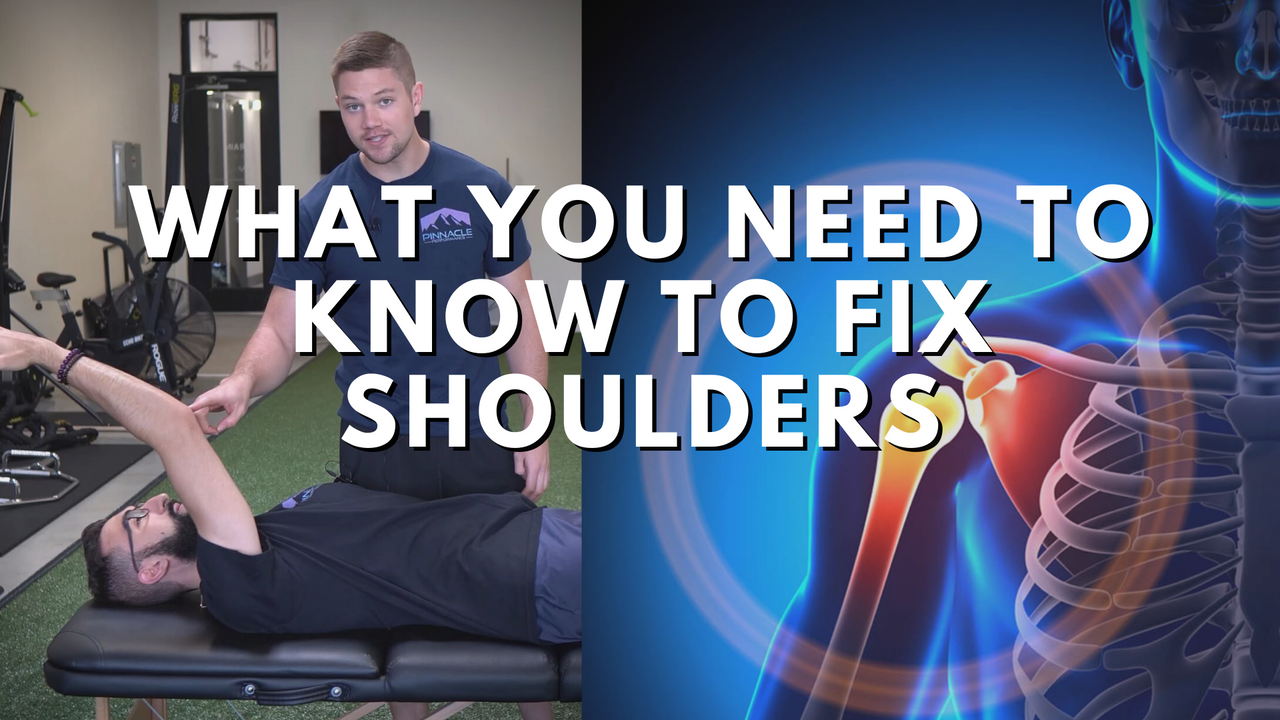
I love working with and teaching on the shoulder because once you understand the basic biomechanics behind it, shoulder health becomes a much less confusing concept.
We can identify the exact root cause of the limitations, and work out from there to best choose exercises and adequate progressions for the individual.
In this article, I will discuss:
- The biomechanics of shoulder function
- How we can compartmentalize regions of the shoulder and ribcage
- Assessments for identifying the location of movement restrictions
- Examples for improving shoulder health & function
If you would rather watch than read, see below:
The Biomechanics of Scapulohumeral Rhythm
It's first important to understand that the shoulder is made up of the scapula, humerus, collarbone, and connective tissue. To keep things relatively simple, I will be focusing on the primary mechanics of the scapula and humerus, but we should appreciate that things are a bit more complex than what I'm going to lay out here.
The scapula and humerus lie on top of the ribcage. I've said this over and over again in different videos and content: If your ribcage isn't in a position that allows your scapula to glide on it, everything else will be compromised to some degree.
Before we get into the next section, see below for the general movements of the scapula as I'll be using these terms throughout the rest of the article:

With that in mind, let's take a look at the mechanics of Scapulohumeral Rhythm, a concept that will lay the foundation for how we understand the shoulder. I'll be breaking it down in three different zones of shoulder flexion:
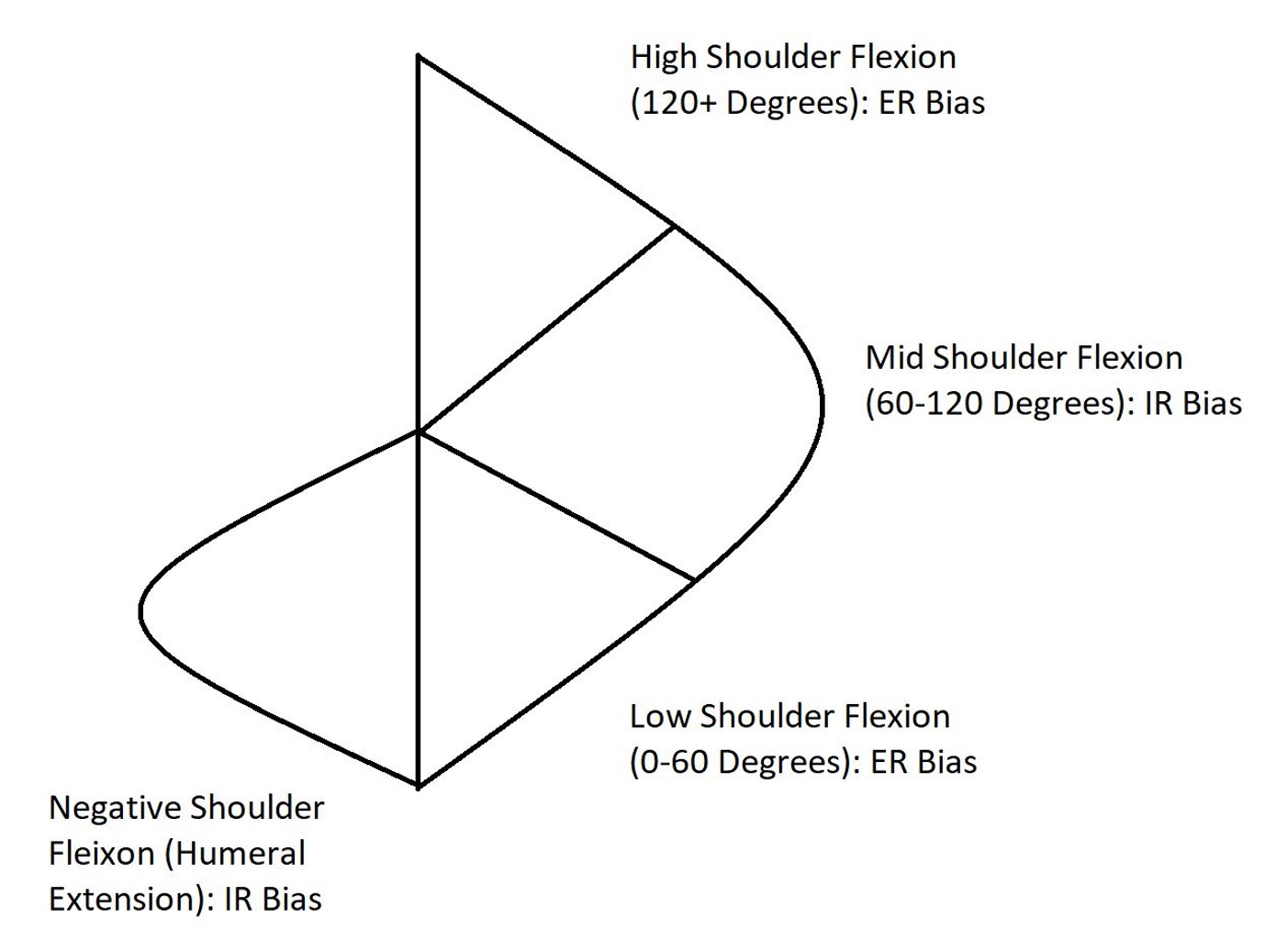
Technically shoulder extension (arm behind the body) is a zone as well, but we won't worry about that for now.
0-60 Degrees of Shoulder Flexion
From the point of raising our arm from our side up to about 60 degrees of flexion, there isn't much movement of the scapula compared to higher degrees of shoulder flexion.
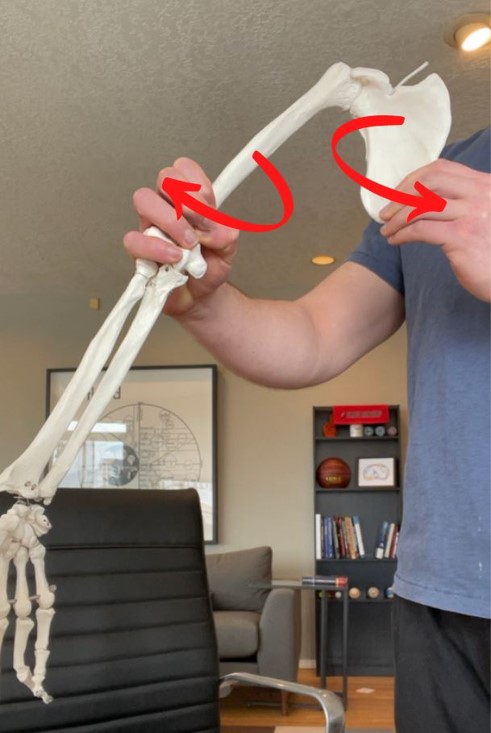
The humerus is moving into external rotation, and because the scapula isn't moving much, we refer to this as relative scapular internal rotation.
60-120 Degrees of Shoulder Flexion
As we move beyond the first zone of 0-60, the scapula is going to need to progressively upwardly rotate, especially after 90 degrees.
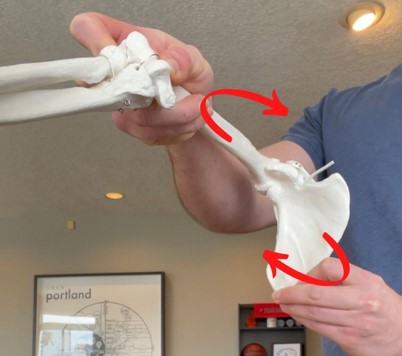
The humerus is moving into internal rotation, but remember that the scapula needs to stay secured on the ribcage. In order to prevent the scapula from "falling off" the ribcage, we will externally rotate the scapula to allow for this to happen in the presence of more upward rotation.
This means that scapular external rotation muscles such as the Serratus Anterior, Rhomboids, and Low Traps will begin to activate more.
![Improve Scapula Control – [𝗣]𝗥𝗲𝗵𝗮𝗯](https://theprehabguys.com/wp-content/uploads/2019/10/scaptipping-1.jpg)
120-180 Degrees of Shoulder Flexion
At this point, the scapula is fairly upwardly rotated, but we still need to get our arm overhead. So what can we do?
What happens in this range is that the scapula is going to posteriorly rotate to allow for the arm to get further overhead:
The scapula is still externally rotated, but the humerus is going to move from a position of internal rotation to external rotation. The humerus moves more than the scapula here so we refer to this as relative scapular internal rotation in the presence of humeral external rotation.
Ribcage Chambers
If that wasn't already enough information, we have another layer to add on top. Don't worry, it gets easier after this.
I divide the ribcage into three main sections to make things easier to isolate and understand. I section these off by location of the vertebrae, meaning the area between (and including) these vertebrae will be considered a section, or "chamber" of the ribcage:

Now we can use the following assessments to understand where exactly the restrictions are. These tests will determine if there is "tightness" or excessive concentric orientation limiting the ability for the ribcage to expand in that area during breathing. If an area cannot expand during normal inhalation, then that means the tissues in that region are too tight to let go, and air will be pushed to the path of least resistance which is a different area of the ribcage, or the belly.
Shoulder Flexion: Full Scapulohumeral Rhythm
This is a measurement of how well your scapula and ribcage function together. Depending on the region it measures for:
0-90 Degrees: T8 & Below Expansion
90-120 Degrees: T5-7 Expansion (mostly posteriorly, but also somewhat anterior as well)
120+ Degrees: T2-4 Expansion
You can then cross-reference and double-check your results with what you see in those assessments with the following tests that are more isolated:
Shoulder External Rotation:
This is a measurement of posterior T5-7 expansion. Ideal range of motion is 90 degrees.
Shoulder Internal Rotation:
This is a measurement of anterior T5-7 expansion. Ideally we want 70 degrees.
Shoulder Adduction:
This is a measurement of both anterior and posterior T2-4 expansion. Ideally we want 30 degrees here.
So for example, if I assessed someone who had:
Shoulder Flexion: 100 Degrees
Shoulder External Rotation: 60 Degrees
Shoulder Internal Rotation: 40 Degrees
Shoulder Adduction: 30 Degrees
We would assume their problems lie within the T5-7 region.
I give many more examples of full assessment results and interpretations of the more complex cases in my Biomechanics Program.
Exercises to Improve Shoulder Health
In terms of Scapulohumeral Rhythm, we can use those concepts to improve the assessed limitations.
I will give examples of exercises for each section of the ribcage, but remember that sometimes there are issues primarily on one side of the body, or in multiple sections. If you want more information and to see full progressions, check out my Biomechanics Program. Both the main program and beginner program cover these concepts.
The key first is to get the ribcage in a good position via restoring expansion capabilities. Remember that if the ribcage isn't in a position to allow for the scapula to glide on it, then everything else will be compromised. After we get the expansion back we want, we can get more isolated with muscular-driven interventions like in my Shoulder Impingement article.
Exercises to Improve Expansion at T8 & Below
If someone was restricted here, we would expect their shoulder flexion to be 90 degrees or less. In order to improve the capabilities of expanding the ribcage here, using reaches that are overhead are helpful because it will open up the space below the scapula.
It is true that muscles in the T5-7 and above regions will become more active, but that's okay because our goal is to expand below that region. Therefore, I will use these higher reaches even with people who don't have genuine shoulder flexion past 90 degrees:
Technique used with permission. Copyright © Postural Restoration Institute®2022. www.posturalrestoration.com
Exercises to Improve T5-7 Expansion
For this, it depends on if we want more anterior or posterior expansion.
For posterior expansion, we want to open up the space in between the scapula and the spine, as that is where that T5-7 region is located. We can use exercises that help move the scapula away from the spine such as:
Exercise credit: Bill Hartman. https://billhartmanpt.com/
We can also isolate one side of posterior T5-7 by moving the spine away from the scapula with trunk rotation:
For anterior expansion, it benefits us to be in more of a prone position (chest facing downward), as gravity will act to push air naturally forward into our ribcage. Remember that anterior T5-7 expansion requires shoulder internal rotation (Scapulohumeral Rhythm), so biasing a 90 degree reach in a prone position will help us accomplish that:
Technique used with permission. Copyright © Postural Restoration Institute®2022. www.posturalrestoration.com
If you're looking for more strategies to improve movement to help your clients feel great, check out my free webinar: 5 Strategies To Help Your Clients Feel 85% Better Immediately
Exercises for T2-4 Expansion
For this, we want to make sure we are reaching low. Low reaches below 60 degrees will eccentrically orient, or stretch out, the muscles that are in this T2-4 region such as the upper traps and levator scapulae:
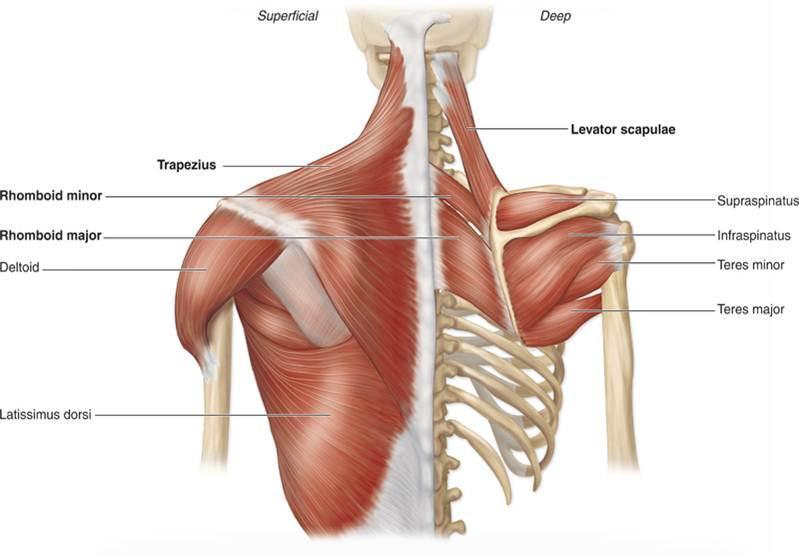
For more posterior expansion at T2-4, supine positions with low reaches will help gravity expand us posteriorly:
For more anterior expansion at T2-4, prone positions are once again our ally for pushing air anteriorly. Also, humeral extension biases more scapular downward rotation, which will pull the scapula toward the spine and close off that area so that we can bias more air going forward:
Summary:
First assess to identify where the limitations of the ribcage are at. Shoulder health starts at the ribcage. Then, select the exercises that will appropriately target the restricted regions.
From there, we can have much more success using muscular-based strategies such as your classic rotator cuff exercises, or an exercise that will help move the scapula into a better position on the ribcage because the ribcage is in a position that will allow the scapula to actually move on it effectively in the first place.
In some cases, we can go after both muscles and the ribcage at the same time. I discuss this much more in detail in my Biomechanics Program.
You should be able to go through an exercise and immediately see improvements in range of motion. If you didn't either the exercise wasn't executed properly, or it wasn't the right exercise based off of your own individual limitations.
"What If I Want More To Specifically Fix My Shoulders?"
If you've read through this and thought, "Conor, this sounds great, but how can I ensure consistent and structured progress there?" or "How about a step-by-step guide to improve my shoulders?", then I've got just the thing for you.
Introducing the THE NO B.S. GUIDE TO SHOULDER HEALTH. It’s designed with the clarity and depth I bring to all my content. With just 15 minutes a day, I’ve streamlined a program tailored for optimal shoulder health, catering to those even with the busiest of schedules.
Why go through tons of exercises, hoping one sticks, when you can follow a methodical program that progresses with you, ensuring not just mobility, but strength through that new range? With detailed 4K videos to guide you, it's almost like having me right there coaching you in real time.
Shoulders are more than just about posture; they're about life quality. The freedom to move, express, and live without restrictions. It’s time to invest in your shoulder health and reclaim that freedom. Check out the NO B.S. GUIDE and start feeling better in no time!
https://www.conorharris.com/shoulder-health-program
Best,
Conor
Don’t miss out on free education
Join our email list to receive exclusive content on how to feel & move better.




